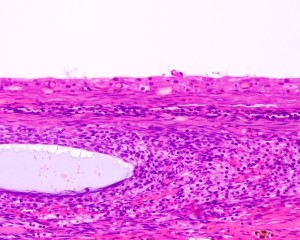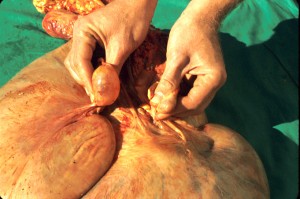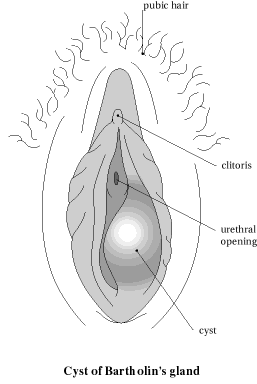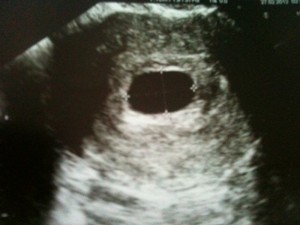What is Follicular Cyst?
Page Contents
It is an odontogenic cyst that arises from the epithelium of the dental lamina and the tooth bud. It is actually another name for Follicular ovarian cyst and is by far the most frequent type of cyst associated with the ovary.
Its width may range from a few millimeters to 15 centimeters or even 6 inches.
Follicular Cyst Meaning
The ovary is part of the reproductive organ of the female body. It comes in pairs and contains eggs. A very sensitive part of the body, it is prone to several illnesses and complications. This includes ovarian cysts. Fortunately most of the cysts developing in various parts of the ovary, including the follicle, are diagnosed as malign. This means that the cyst can be removed without endangering the life of the woman.
Types of Follicular Cyst
Follicular cyst is not limited to the ovaries and may develop in various parts of the body. According to the region of their development, these cysts are classified into various types like:
Picture 1 – Follicular Cyst
Ovarian Follicular Cyst
It is by far the most known type of follicular cyst in the world. It may develop even when ovulation does not occur. Generally, these cysts do not produce any symptoms and resolve in a few months.
Follicular Infundibular Cyst
This type of cyst occurs in the skin – the overlying portions of the epidermis. It manifests as a single lesion but may soon erupt in multiple forms. Due to its development on various areas, such as face, neck, scalp or trunk it is referred to by various other names, such as:
- Epidermoid cyst
- Epidermal inclusion cysts
- Epidermal cysts
The size of these vesicles may vary from two millimeters to even five centimeters. These growths often appear with a gray, yellowish, or brown cheesy material within it that eventually erupts on its own.
Follicular Cyst Causes
This vesicle normally develops during the time of ovulation. Studies reveal that in some cases the sac of the ovary holding the egg fails to break for some reason. Due to this, it does not open and release the egg. This creates an unhealthy environment within the ovarian area making it an ideal place for cyst growth. Due to the pH level of the ovary, some of the cysts simply dissolve on their own after three months. Some cysts may, however, need to be physically removed to help prevent further complications.
Ovarian Follicular Cyst Causes
Some of the factors that may cause the development of ovarian follicular cysts are:
Hormonal Imbalance
Estrogen and progesterone are the two main hormones produced in the follicles that guarantee a timely release of the egg. If an imbalance of these hormones occurs within the ovary, the follicle would fail to receive the signal that it needs to release the egg. It would grow abnormally in size and continue to become larger until it becomes a fully developed ovarian follicular cyst. It is best to seek medical assistance to maintain normal hormonal balance in your body to avoid getting these cysts.
Unhealthy Diet
Food plays an important role in the development of these growths. As a popular saying goes, “you are what you eat.” Studies reveal that individuals who consume very acidic foods, refined carbohydrates, and processed foods (containing too many toxins) are most likely to suffer from this disorder. The toxins need to be flushed out of the system by supplying the body with enough raw and fresh foods. A failure to do this would result in disorders, such as cysts.
Failed Ovulation Process
As aforementioned, the follicles would most likely develop into cysts if ovulation does not occur. The vesicles are likely to disappear on their own. However, if you feel any pain and discomfort near your ovarian section it is best to see your gynecologist for diagnosis.
Women having a family history of this cyst are most likely to suffer from it. Those having an irregular menstrual cycle and having their period before the age of 11 may also be at a higher risk.
Follicular Infundibular Cyst Causes
The exact cause of development of these vesicles is not known. Exposure to sun is believed to have a role in the occurrence of this type. These cysts are also found to develop more in females and those over 60 years of age. Hence, gender and age are supposed to be possible factors for the growth of these abnormal structures.
Follicular Cyst Symptoms
Some of the common symptoms experienced in this condition are:
Pain
The pain is normally felt near the pelvic region. Pain may be triggered due to the fast growth of the cyst that causes the twisting and eventual disruption of the blood supply. It may soon result in bleeding or rupture of cyst. When this occurs, patients are likely to complain of sharp shooting pain in only one side of the body (where the cyst is most likely to be located). At times, this pain may be experienced in the middle of the menstrual cycle quite close to the time of ovulation.
Abdominal Bloating and Cramps
A feeling of fullness is another common symptom of this condition. It may be experienced due to pressing of the cyst on the pelvic organs. Some women may even suffer from nausea due to the abdominal pressure and intense pain that they may experience.
Irregular Bleeding
Although this is a rare symptom of follicular ovarian cyst, women often complain of extremely heavy menstrual flow with spotting in between their periods. Some would experience a delayed cycle followed by a very painful menstrual flow.
Follicular Cyst Complications
Although most follicular cysts are diagnosed as benign, women suffering from them should not be too comfortable with their condition. It is necessary for them to consult their physician because of the various risks it may bring to their health.
Ovarian Cyst Rupture
This is the most common cause of internal bleeding or hemorrhage in women. Immediate medical care is needed due to the possible complications that may arise from it. The pain experienced by affected woman is unbearable and is not to be ignored.
Increased Growth Size
If the cyst grows in size, it would hamper the function of other organs near the ovary. It may cause severe damage to the ovary and cut off its blood supply. This is a very dangerous situation. If doctors recommend an immediate surgery for the removal of follicular ovarian cyst, patients should go ahead and follow the advice without any hesitation.
Infertility
Not being able to be a mother is the most depressing thing for most women. Doctors and researchers are continuously trying their best to find treatment options that would save the reproductive organ of the woman and remove difficulties in child-bearing. Even in case of small cysts, effective methods would cure the problem and reduce the possibility of infertility.
Cancer
Although rare, there is a possibility of cancerous developments from this condition. Eliminate the risks of infecting other cells of the body and seek medical assistance at the soonest.
Follicular Cyst Treatment
The treatment of these cysts may vary depending on the type that one is suffering from and the health condition of the patient. Know about the common treatment methods for both types of this condition:
Picture 2 – Follicular Cyst Image
Ovarian Follicular Cyst Treatment
This type of vesicles can be cured by:
Surgery
Large cysts, which are in danger of getting ruptured and twisting the ovary, would require surgical removal. If the size of the cyst is less than two and half inches, a Laparascopy may be carried out.
Hormonal Therapy
This is recommended by physicians to make the cysts dissolve naturally. The body has to gain hormonal balance to get rid of the abnormal chunk of cells inside your ovary. Hormonal therapy is likely to restore this balance and regulate hormone levels in the body. Women are generally advised by physicians not to take birth control pills during the hormonal therapy as it would complicate the balance that the treatment is aimed to accomplish.
Healthy Lifestyle
Apart from medical treatment, healthy diet, proper sleep, exercise and stress-management measures should be implemented. Diets rich in fruits and vegetables will also help get rid of the toxins within the body.
Follicular Cyst Infundibular Treatment
The treatment for this type of vesicles includes:
Alkaline Treatment
Those suffering from infundibular follicular cysts may apply alkalize pH water along with sea salt on the affected area to help get rid of it. Lowering the acidity of the skin will help eliminate possibilities of further development of this unwanted cyst. It can help increase capillary action and thus remove problems of obstruction.
Drinking Plenty of Water
Drink enough water to get rid of toxins within the body. You may add sea salt to the water you drink for increased potency.
Hot compression
If you feel pain then a mild hot compress applied on it for 15 to 20 minutes will help relieve you from the discomfort. In any case, it is always best to see a doctor for the appropriate diagnosis.
If you suspect yourself to be experiencing symptoms of this disorder, get in touch with a doctor as early as possible. Timely treatment will help you keep all complications at bay and get cured of this condition faster than you can imagine.
References:
http://en.wikipedia.org/wiki/Follicular_cyst_of_ovary
http://www.emedicinehealth.com/ovarian_cysts/article_em.htm
http://www.nlm.nih.gov/medlineplus/ency/article/001504.htm
http://www.ovarian-cyst-symptoms.info/Follicular-Cyst.html




